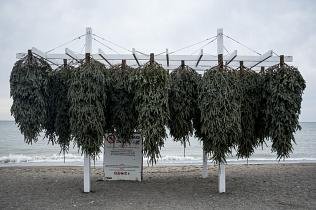Have a Look at Cool, Quirky art Installations Lining Toronto’s Beaches this Winter
A Japanese hot spring, an inverted forest, a wooden lighthouse—those are just some of the unusual structures dotting Toronto’s eastern beaches this month. The installations are part of the third annual Winter Stations Design Competition, in which architects and artists transform mundane lifeguard posts along Kew, Scarborough and Balmy Beaches into surreal works of art. We spoke to the designers of the eight projects, which were chosen from more than 350 submissions, about their installations.

The Beacon
Joao Araujo Sousa (quoted) and Joanna Correia Silva • Porto, Portugal
“The Beacon is an interpretation of a lighthouse. We chose it for its
symbolism: lighthouses attract attention, warn people and mark special
occasions. It’s a way to highlight the social challenges the world faces
in a time of political uncertainty. We intend for it to be a temporary
donation hot spot, with a few openings for donated goods like food or
clothes for local charities. The installation is made from weathered
cedar to look as if it always belonged on the beach.â€â€”Joao Araujo Sousa

Collective Memory
Mario GarcÃa and Andrea Govi • Barcelona and Milan
“Our installation, made from hundreds glass bottles, is inspired by the
refugee crisis, Brexit and the rise of populist politics. It celebrates
Canada’s openness towards immigrants. We took the idea of a ‘message in a
bottle’ to make the installation interactive: we encourage people to
write down their own memories and leave them inside one of the bottles.
They each containe one message, one story, one life. All those stories
together make the history of Canada.â€â€”Mario GarcÃa

North
Studio Perch • Montreal
“We were inspired by the vast boreal forests and the north. We
suspended 39 fir trees upside down from a wood frame structure, which is
held up by posts and anchored to the lifeguard station.â€â€”Suresh Perera

BuoyBuoyBuoy
Rob Shostak, Dionisios Vriniotis, Dakota Wares-Tani and Julie Forand • Toronto
“In open water, buoys attempt to delineate boundaries in something that
is in constant flux. Our installation consists of hundreds of CNC-milled
units that are shaped like buoys. The majority are made of
weather-treated wood, but some are milled from thick plexiglass. We
painted the wood pieces white laminated them a mirrored vinyl, creating
three types of buoys. They fit together using a slotting system that
allows them to be reconfigured in infinite ways.â€â€”Rob Shostak

The Illusory
Humber College’s School of Applied Technology andSchool of Media Studies & IT • Toronto
“The Illusory is inspired by places that foster moments of
introspection, like sacred spaces or gardens. The installation
comprises 40 posts of varying heights constructed from fibreboard and
wrapped with reflective vinyl. After entering the installation,
participants can see fragmented versions of themselves and the
environment.â€â€”Cole Swanson

I See You Ashiyu
Asuka Kono and Rachel Salmela • Toronto
“I’m a big fan of hot springs and public baths—I used to go once a week
when I was living in Japan. They’re a great space to communicate with
family, friends and even new people. We wanted to encourage this type of
social interaction in Toronto [and have people dip their feet in]. We
used cedar to tie in the sense of smell associated with bathing
traditions. The tub is connected to a wood-burning stove that doubles as
a heater for a small waiting area on the opposite side of the station.
Visitors and volunteers will tend to the fire.â€â€”Asuka Kono

Flotsam and Jetsam
University of Waterloo • Waterloo
“We were shocked by the Ellen MacArthur Foundation’s prediction that, by 2050, the weight of the plastics in the oceans will be greater than the weight of all fish. Flotsam and Jetsam invites
visitors to consider how they can change their behaviour and reduce the
amount of waste. The installation is made out of wire mesh panels,
which we cut and assembled into cubes, then filled with plastic
containers—mostly water bottles—collected from students and the local
community.â€â€”Carly Kandrack

Midwinter Fire
University of Toronto’s Daniels Faculty of Architecture, Landscape and Design • Toronto
“The installation is an enclosure surrounding a planting scheme of
Betula Papyrifera (paper birch) and Cornus Sanguinea (red dogwood) that
emulates a fire emerging from the wood chips. “—Peter North
Comments
There are 0 comments on this post





